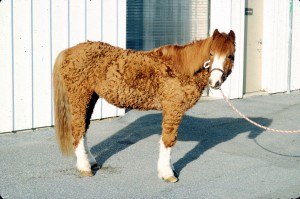 ‘Cushing’s disease’ (or as it is correctly termed, Pituitary Pars Intermedia Dysfunction, PPID) is a condition that affects the horse’s hormonal system. In a healthy horse the Hypothalamus and Pituitary gland, which are located in the brain, are responsible for nerve action that promotes the release and production of hormones. These hormones are chemical signals which tell the body to do certain things, and are transported around the body via the blood stream. In horses and ponies suffering from Cushing’s disease, the Pituitary gland is affected either by enlargement/swelling of the gland or by presence of a tumour, which in turn puts pressure on the Hypothalamous. This results in the horse not being given the correct information about how much of each hormone to release. The result is a constant release of the hormone ACTH and increased Cortisol production, which gives us the classic symptoms associated with the disease. Older horses and ponies are normally affected, however Cushing’s has been diagnosed in horses as young as 4. Cushing’s is equally likely to develop in all horses and ponies, regardless of gender or breed. Your vet can test your horse or pony for Cushing’s disease by performing a blood test. What can I expect to see in a Cushing’s horse? The excessive levels of Cortisol (the stress hormone) has widespread effects on the health of the horse. Probably the most identifiable symptom of Cushing’s is the development of a coarse, curly, shaggy coat, caused by a lack of normal moulting and shedding of hair. The high level of Cortisol also suppresses the immune system, leaving the horse more likely to suffer from parasites and infections, including hoof/tooth abscesses, and makes wounds slow to heal. Muscle tissue is broken down, leading to muscle wastage, stiffness, sway backs and pot bellies. Typically insulin levels are increased, which makes PPID sufferers more likely to suffer from chronic laminitis and Equine Metabolic Disease. Due to the depressed immune system and excessive coat, regulation of body temperature is often a problem and excessive thirst and urination are also seen. How to manage a Horse with Cushing’s Disease Horses with Cushing’s disease require a low sugar and low starch diet, similar to horses with EMS or laminitis. Make this easy by choosing feeds approved by the Laminitis trust, and soaking hay to reduce sugar levels. If the horse is turned out, consider using a grazing muzzle or strip grazing to reduce grass intake. If your horse needs to gain condition unmolassed sugar beet and oils can be included as a safe source of calories. Ensure sufficient water is always available due to increased levels of drinking. Horses are seen to thrive when exercise is combined with correct diet and management! Horses suffering from Cushing’s benefit from being clipped, which makes them less likely to sweat and get fungal skin infections. If they have been clipped they will need to be rugged and have shelter in cold weather, and shade on hot days. By grooming regularly you promote healthy skin, and wounds and infections are observed more quickly. As with all horses, routine worming, dental care, farriery and vet care is important. Some horses are prescribed ‘Pergolide’, a common medication in the management of Cushing’s Disease, which works by increasing dopamine production and reducing Pituitary gland activity to stabilise hormone production. For those wanting a more natural way to help your horse deal with Cushing’s without the need for medication, supplements containing Chastetree berry are commonly used. Olivia Colton MSc Nutritional and Technical Coordinator Feedmark
‘Cushing’s disease’ (or as it is correctly termed, Pituitary Pars Intermedia Dysfunction, PPID) is a condition that affects the horse’s hormonal system. In a healthy horse the Hypothalamus and Pituitary gland, which are located in the brain, are responsible for nerve action that promotes the release and production of hormones. These hormones are chemical signals which tell the body to do certain things, and are transported around the body via the blood stream. In horses and ponies suffering from Cushing’s disease, the Pituitary gland is affected either by enlargement/swelling of the gland or by presence of a tumour, which in turn puts pressure on the Hypothalamous. This results in the horse not being given the correct information about how much of each hormone to release. The result is a constant release of the hormone ACTH and increased Cortisol production, which gives us the classic symptoms associated with the disease. Older horses and ponies are normally affected, however Cushing’s has been diagnosed in horses as young as 4. Cushing’s is equally likely to develop in all horses and ponies, regardless of gender or breed. Your vet can test your horse or pony for Cushing’s disease by performing a blood test. What can I expect to see in a Cushing’s horse? The excessive levels of Cortisol (the stress hormone) has widespread effects on the health of the horse. Probably the most identifiable symptom of Cushing’s is the development of a coarse, curly, shaggy coat, caused by a lack of normal moulting and shedding of hair. The high level of Cortisol also suppresses the immune system, leaving the horse more likely to suffer from parasites and infections, including hoof/tooth abscesses, and makes wounds slow to heal. Muscle tissue is broken down, leading to muscle wastage, stiffness, sway backs and pot bellies. Typically insulin levels are increased, which makes PPID sufferers more likely to suffer from chronic laminitis and Equine Metabolic Disease. Due to the depressed immune system and excessive coat, regulation of body temperature is often a problem and excessive thirst and urination are also seen. How to manage a Horse with Cushing’s Disease Horses with Cushing’s disease require a low sugar and low starch diet, similar to horses with EMS or laminitis. Make this easy by choosing feeds approved by the Laminitis trust, and soaking hay to reduce sugar levels. If the horse is turned out, consider using a grazing muzzle or strip grazing to reduce grass intake. If your horse needs to gain condition unmolassed sugar beet and oils can be included as a safe source of calories. Ensure sufficient water is always available due to increased levels of drinking. Horses are seen to thrive when exercise is combined with correct diet and management! Horses suffering from Cushing’s benefit from being clipped, which makes them less likely to sweat and get fungal skin infections. If they have been clipped they will need to be rugged and have shelter in cold weather, and shade on hot days. By grooming regularly you promote healthy skin, and wounds and infections are observed more quickly. As with all horses, routine worming, dental care, farriery and vet care is important. Some horses are prescribed ‘Pergolide’, a common medication in the management of Cushing’s Disease, which works by increasing dopamine production and reducing Pituitary gland activity to stabilise hormone production. For those wanting a more natural way to help your horse deal with Cushing’s without the need for medication, supplements containing Chastetree berry are commonly used. Olivia Colton MSc Nutritional and Technical Coordinator Feedmark
What is Cushing’s disease?
13 Apr 2015
